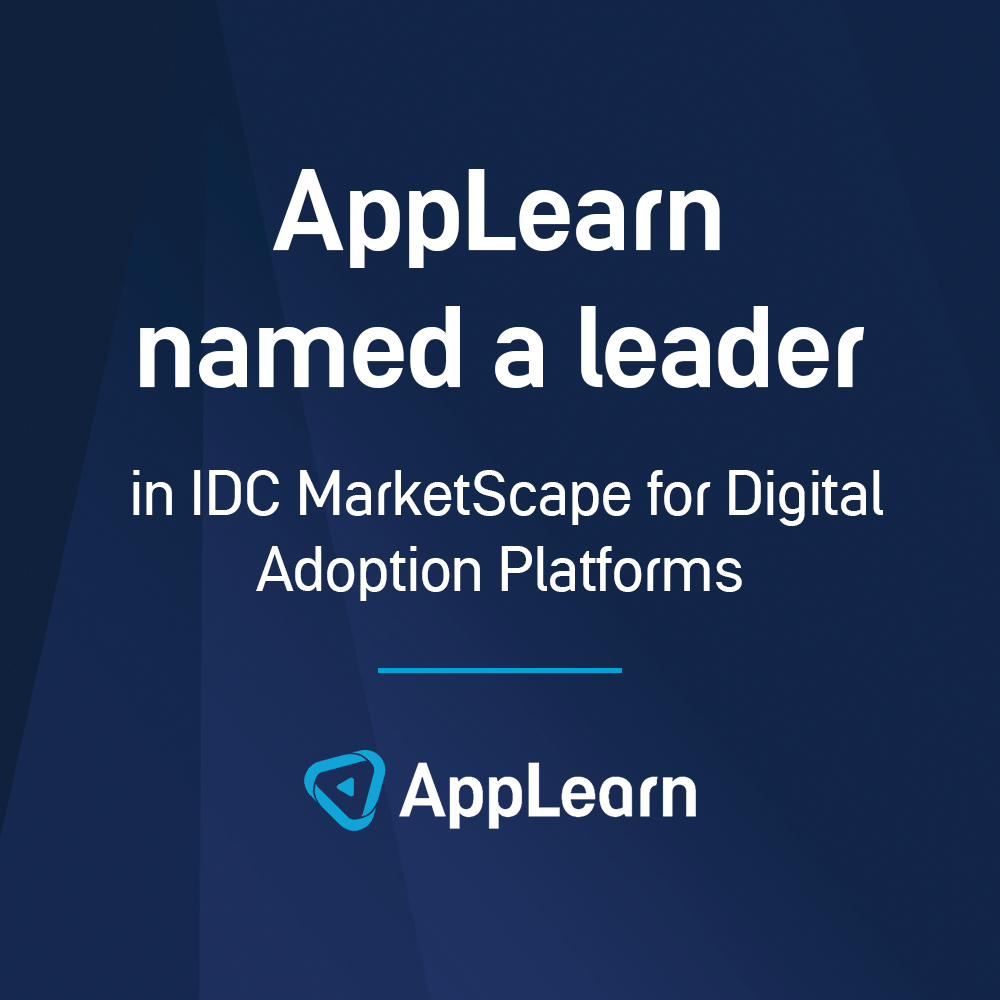News
How to improve the Digital Employee Experience with a DAP
How to improve the Digital Employee Experience with a DAP
The world of work is getting more digital by the day. We’re spending more time online, using tech and travelling across multiple applications to get our work done. But are we doing this in the most efficient, effective way?
In this guide, we’re going to take a look at the digital employee experience, but focus on how you can support it and create a better way of working for your teams. You’ll find out more about software that can drive digital adoption, support your employees and keep associated costs down for your organization. So, let’s get into it.
What is the digital employee experience?
Plenty of us use technology to support our working day. In fact, you might spend the majority of your day at a computer. You might use an app to log absences. You might use complex software to support your work every day. Wherever you fall along this spectrum and whatever your role or sector, you’re bound to be impacted by what many these days call ‘digital employee experience’: how we interact with different applications, software and technologies throughout the day.
Ultimately, the digital employee experience (DEX) can be looked at in two ways:
- The way people interact with different applications throughout their working day
- The strategy a business has for this experience and associated effectiveness
We’re going to delve into the tools that can support digital employee experience and how it is intertwined with digital adoption in this guide, but if you want to find more about the topic as a whole and how to create an employee experience strategy, check out our Ultimate Guide to Digital Employee Experience.
Why is digital employee experience important?
Digital employee experience is a key aspect of someone’s working life – especially if they are using multiple applications to fulfill their role.
We know because we’ve done the research. In our Hidden Cost of the Digital Employee Experience report, underpinned by research from YouGov, we uncovered some eye-opening stats:
- 76% of people spend up to 6 hours using business applications every working day
- On average, employees spend 3 hours each week navigating between different applications
- Large businesses in the US are losing 172,091 hours a year to employees searching for tech support
- In total, US large businesses could be missing out on $6m every year due to lost productivity
While there’s a clear business case for focusing on digital employee experience, above all else, the driving force should be to create an environment that helps people do their job effectively. Get digital employee experience right, and it can be the difference between a frustrated member of your team, and one who feels empowered, motivated and supported to complete their best work.
What are digital adoption platforms?
A digital adoption platform (or DAP) is an intelligent piece of software that can support your employee experience efforts. Put simply, it makes business applications easier to use. It will help you to analyze and improve how your teams interact with key software, measuring employee experience at the same time.
By overlaying your chosen application(s) – including Salesforce, Workday, Cornerstone, Oracle and more – a DAP ‘learns’ how people use and interact with software. It uses data to identify recurrent issues and puts interventions in place to help software users solve them there and then, while also preventing them in the future.
For example, someone might be tasked with using a particular application to upload a document to a key portal. This person might have used the application in question before, but not had to locate and use the portal. They could spend time navigating back and forth between different areas of the application, perhaps repeatedly uploading the document to the wrong area.
They look for a chatbot or a Help section – and can’t immediately find one. Frustration is rising. Time is adding up. It might, on the surface, seem like a minor inconvenience, but consider this could be happening across multiple applications a day. Extrapolate this to hundreds (if not thousands) of employees and you start to see how important getting the digital employee experience right is.
Add a DAP to the mix and key interventions, delivered at the right point in time, can prevent these issues from occurring. By tracking how people use applications, a DAP can detect if people are struggling with certain functions, and provide useful tips and support – at the exact moment they need it – to help them complete the task in hand. This could be a timely in-app chatbot or a pop-up with a relevant ‘How To’ guide.
Want a little more detail on how DAPs work? Our guide on digital adoption and DAPs is a useful jumping off point.
How do digital adoption platforms support digital employee experience?
DAPs mean you can offer consistent support to employees across applications, creating a digital employee experience that meets your people’s needs. Broadly, DAPs can:
Improve engagement and productivity
We can’t always predict when people will encounter a tech challenge. But we can, through a DAP, have the insight into what is creating friction. Analytics gathered through a DAP can shine a light on the issues your people are facing. The targeted in-app support can help to simplify workflows and keep app users engaged, delivering a frustration-free experience.
Accelerate training and onboarding
An employee’s first touchpoint with an application should provide them with the support and training needed to use it effectively in the future. And with a DAP, you can create a personalized, user-friendly onboarding process, helping to deliver a digital experience that is tailored to them.
Provide software support when it’s needed
The software we use at work isn’t static, and frequent updates and releases, across multiple applications, can prove a challenge for people to use and for you to communicate to employees. The tailored in-app support that a DAP provides can help your people to navigate software changes and build their knowledge of new features and functions.
Support remote or hybrid working
Though a good digital employee experience has always been important, the overnight global shift to remote and hybrid working has certainly accelerated it up the agenda. The sheer scale of change meant businesses had to act fast, but there may be gaps in the software introduced to help people stay connected and productive at work. And if face-to-face training isn’t possible, it could only compound the challenge. DAPs provide analytics for you to know your people are effectively engaging with new and existing software, and the resources and guidance your teams need to complete their work, no matter where they are based.
DAPs and the digital employee experience – how does it work?
We recently worked with King’s College London to maximize their training resources for software used by 7,000 people. Wanting to improve engagement with Unit4 Enterprise Resource Planning, the team initially planned to produce a video to support its roll-out across the organization.
Having worked with their HR team previously, AppLearn provided an overview of how our own digital adoption platform, Adopt, could overlay Unit4. Seeing the ease of set-up and configurability possibilities of the platform, the King’s team realized a DAP would be a more intuitive route to help engage, train and support users of Unit4.
Ahead of roll-out, we worked with the team to help create the process, training and FAQ resources that would be embedded into the software, through the use of Adopt. DAPs such as our own can provide step-by-step guidance as a person uses an app, to help them navigate key functions, supporting task completion and accuracy.
By easily embedding Adopt into Unit4, King’s has seen:
- 66% reduction in admin time on expense approvals
- 25% time saving through in-app support
- 32% user increase for targeted processes
“AppLearn have enhanced our software in a way I haven’t seen in any other organization,” Mayur Odedra, Systems Manager at King’s College London told us, “Throughout the lifecycle of the project AppLearn were incredibly helpful – from project plan and setup to ongoing support. Adopt has not only given us an improvement to the employee experience, but brought us much, much closer to our users.”
Want to know more? Read the full King’s success story to see firsthand how Adopt has revolutionized their approach to digital employee experience.
Getting started with a DAP
You understand why digital employee experience is critical to your people and your business. You know that a DAP could help. So, where do you begin when introducing a platform to your organization? Following a digital employee experience framework to create an appropriate strategy is the right way to tackle some of the tech challenges your people will be facing.
You should check out our simple seven-stage framework for the best outcome, but a key recommendation is to gather a full picture of the software your people use and the problems they might be facing with it. Explore if you can get actionable data on this to get a proper understanding of the digital environment your employees operate in.
This should identify the areas that need attention, and then opens the possibility of seeking a DAP to help address these challenges. The application(s) you need support with, the data you’re looking to gather, the skills you’re wanting to train should then inform your decision on the vendor you want to speak to. And if that brings you to AppLearn, we couldn’t be happier.
DAPs are an increasingly popular tool for major businesses across the globe. EY, Abbott, Cushman & Wakefield are just some of the market-leading organizations that use Adopt to give their employees better support. Interested in seeing how Adopt could help your teams? Watch our simple explainer video below.
Article by
Daniel Gripton
Share this article





